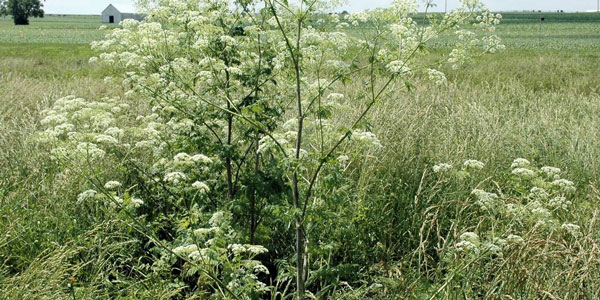
Apiaceae is a family of plants containing poison hemlock, often referred to as poison parsley. Carrots, celery, and parsnips are some other vegetables that belong to this plant family. In addition to the fern-like look of the leaves, the blooms of poison hemlock are composed of clusters of white, umbrella-shaped petals. Because of this, several individuals throughout history have erroneously identified poison hemlock as wild carrot, wild parsnip, or wild parsley.
The Europeans introduced this plant to this region sometime in the 1800s, and it has since spread throughout North America. The poison hemlock spread out of their gardens and is now found in the surrounding areas, including the roadsides, streams, irrigation ditches, meadows, and cultivated fields. The poison hemlock tree prefers to thrive in moist soils, although sometimes it may survive in soils that are just slightly damp. It has been discovered in cultivated areas, pastures, and gardens.

Identification
In the first year, a poison hemlock plant develops into a rosette, but the plant does not produce flowers until the second year. Each blossom eventually transforms into a green, strongly ridged fruit and contains several seeds. Once it has reached maturity, the fruit becomes greyish brown. It is a biennial, but it may turn into a perennial under the right circumstances. It can grow to be between 3 and 8 feet tall, and it can even sometimes reach 10 to 12 feet.
It is possible to tell a poison hemlock plant from a carrot or parsnip plant thanks to the large purple patches covering the stem. In addition, there are no hairs or rough patches on the stem. Additionally, the leaves are hairless and silky; they have a glossy green colour, are finely split, and resemble ferns. Eight different alkaloids are responsible for poison hemlock's toxicity. The odour often produced by poison hemlock is described as being quite similar to mouse urine.
Toxicity
Poison hemlock is deadly, including its leaves, stem, fruit, and root. During the spring, up to the point when the plant produces flowers, the leaves are at their most toxic. In most cases, poisoning symptoms manifest within an hour after the animal has consumed the plant. Within two to three hours, animals will succumb to respiratory paralysis and perish. The following are some signs to watch out for in animals:
- a reduction in one's appetite
- Excessive salivation, bloating, and a quick but weak pulse are indications of muscle incoordination.
Other symptoms include shaking of the muscles, diarrhoea, frequent urination, and a feeling of "nervousness." Before cardiac arrest occurs, the cessation of breathing in dying animals is brought on by respiratory paralysis. Crooked legs (also known as crooked calf disease or arthrogryposis), cleft palates, and kinked tails are some birth deformities that may develop in animals due to swallowing less than the quantity of poison hemlock that would be considered deadly. When pregnant cows consume poison hemlock between the 40th and 70th day of their pregnancies, their offspring are more likely to be born with arthrogrypotic skeletal abnormalities.

Management
Treatment by Mechanical Means
Poison hemlock may be prevented from becoming established with frequent ploughing or cultivation. Poison hemlock may be dug out successfully if discovered early, and the plant population is kept low. When digging or mowing in areas with poison hemlock, use extreme caution; when handling this plant, be sure to protect yourself using a mask and rubber gloves. Toxins from plants have the potential to be absorbed via the skin on days when the temperature is high.
Burning the plant is not recommended since the smoke may contain lethal poisons. Hemlock is so deadly that some of its alkaloid components can enter into milk when animals feed on sublethal doses of this Deadly' Plant. This can potentially negatively impact the taste and safety of milk humans consume.
Chemical
Herbicide treatment of poison hemlock is most successful when applied during the late spring or early summer months. A few different combinations of herbicides are successful, one of which being 2,4-D plus dicamba (2.5 pounds plus one-pound active ingredient per acre). Glyphosate and triclopyr have also been used, and both have had positive results. For the best results, herbicides should be applied to seedlings or tiny rosettes rather than fully established plants not to harm the crop. Many treatments may be necessary to eradicate the problem until the seed bank has been exhausted.

Please use extreme care; spraying herbicides within fifty feet of a body of water may cause serious damage to the surrounding ecosystem and normally requires using an aquatic herbicide. Get in touch with the weed control authorities in your area or the OSU Extension for particular herbicide recommendations, and be sure to read the label on the herbicide to see if there are any limitations.



